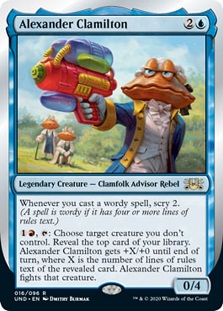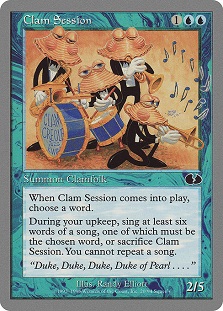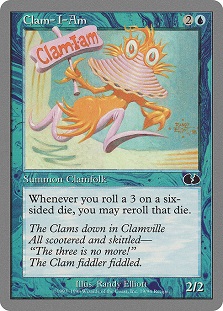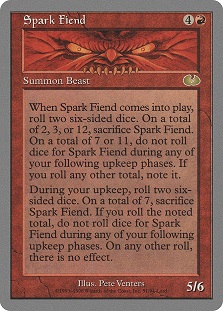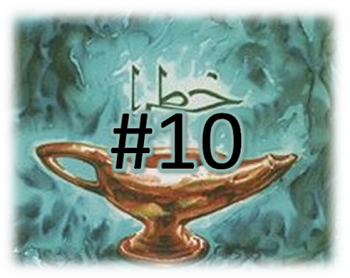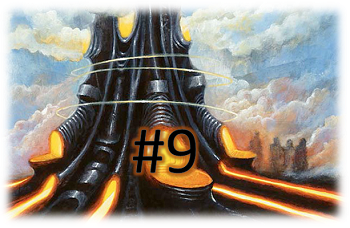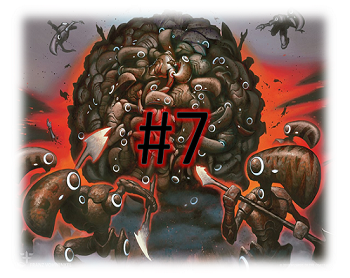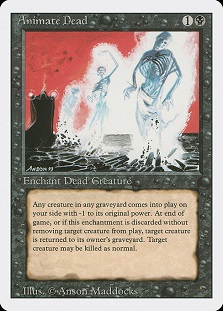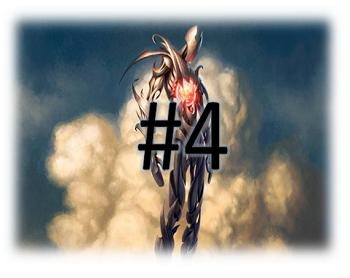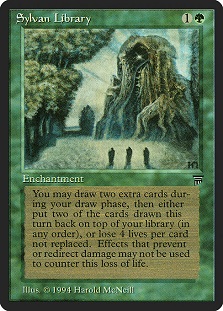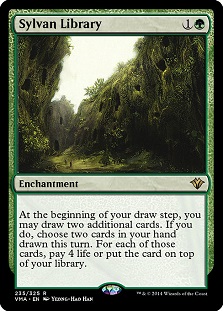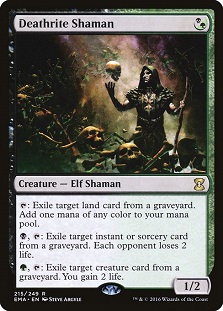(Alexander ClamiltonAlexander Clamilton | Art by Dmitry Burmak)
Ramble On
Welcome to Too-Specific Top 10, where if there isn’t a category to rank our pet card at the top of, we’ll just make one up! (Did you know that Dance of the DeadDance of the Dead is the only 'Enchant Dead' that actually buffs the creature you recur?)
Much to the chagrin of my editors, I have been known to carry on a bit. I've always blamed this on the fact that I went to Seminary as a kid (and Seth begat Enos, and Enos begat Cainan, and Cainan begat Mahalaleel, and Mahalaleel begat Jared, and Jared begat Enoch, and Enoch begat Methuselah...), but whether that's the truth or not, I for some reason have no idea how not to make my sentences into three-part monstrosities that don't seem to know how to come to an end. Could that last sentence have technically been a paragraph? Probably. Will I fix it to be so? Probably not.
Luckily, this last week Wizards of the Coast decided to reward me for my butchering of cognitive thought and general written language with the printing of a new card that celebrates the long-winded:
There's a lot to unpack here, so I'll try to be brief.
Then again, would that be in the spirit of things? I think not! So let's start with the name. Alexander Clamilton is a play on words referring to one of the founding fathers of the United States of America, the first Secretary of the Treasury, Alexander Hamilton, only in this case he's from an alternate silver-bordered universe where he is a Clamfolk who has discovered the might of a supersoaker. At twenty paces. Given the famous duel between Aaron Burr and Alexander Hamilton, this also explains Alexander Clamilton's second ability to fight a target creature, although some artistic license has been taken to have the might of his fight determined by the convolutedness of his given argument revealed from the top of the library. This particular affinity for words is also represented in Alexander Clamilton's first ability, although luckily not with Affinity, but rather with the ability to scry 2 anytime you cast a spell with four or more lines of rules text.
But why stop at four? Heck, just going through Alexander Clamilton's various creature types we can do better than that!
Wordy Clamfolk
Out of the three total Clamfolk pre-dating Alexander Clamilton, two of them are considered "wordy". Clam-I-Am shames its fellow Clamfolk with its two-line brevity, although given that it's an obvious shout-out to Dr. Seuss it's actually very on-theme. Clambassadors then comes in at five lines of rules text, although they are also forgiven given this left enough room for a shout-out to some of the best flavor text in magic's history. Finally, Clam Session comes in with the greatest amount of rules text on a non-Alexander Clamfolk at six lines of rules text, but I still feel that we can do better.
Wordy Rebels
Given the search abilities that the Rebel Tribe is built upon, they are naturally quite a wordy bunch. I, for one, expected Lin Sivvi, Defiant HeroLin Sivvi, Defiant Hero to be at the top of that list, but it actually tied Clam Session and several other Rebels by coming in at six lines of rules text. Defiant Vanguard, on the other hand, picked up the slack with both a wordy search ability and a wordy Thicket BasiliskThicket Basilisk-but-for-both-creatures blocking ability. This came out to an impressive seven lines of rules text, making this dagger-wielding suicide squad tied for the wordiest Rebel with Alexander Clamilton, himself.
Wordy Advisors
Lastly, we have the most flavorfully wordy of the creature types: the Advisor. While Rules Lawyer makes a valiant attempt, the real Advisors living up to the wordy birthright that comes from devoting your life to bureaucracy and long-windedness are the Persistent PetitionersPersistent Petitioners. Tying Alexander Clamilton at seven lines of rules text, even despite being a common, Persistent PetitionersPersistent Petitioners are the first of the listed cards that share a type with him that is relevant, and which could also seamlessly go into an Alexander Clamilton deck and work strategically as well as thematically.
Which is, of course, why I immediately built the deck as soon as he was spoiled.
Heretofore Referred To As Clamilton, Et Al
View on ArchidektCommander (1)
- 1 Alexander ClamiltonAlexander Clamilton
Artifacts (10)
- 1 Folio of FanciesFolio of Fancies
- 1 Heirloom BladeHeirloom Blade
- 1 Herald's HornHerald's Horn
- 1 Illusionist's BracersIllusionist's Bracers
- 1 Knowledge PoolKnowledge Pool
- 1 Mirror of the ForebearsMirror of the Forebears
- 1 Noetic ScalesNoetic Scales
- 1 Sands of TimeSands of Time
- 1 Storage MatrixStorage Matrix
- 1 Vanquisher's BannerVanquisher's Banner
Creatures (30)
- 29 Persistent PetitionersPersistent Petitioners
- 1 Phantasmal ImagePhantasmal Image
Enchantments (8)
- 1 Curse of OpulenceCurse of Opulence
- 1 Faces of the PastFaces of the Past
- 1 Intruder AlarmIntruder Alarm
- 1 Mirror MarchMirror March
- 1 Pemmin's AuraPemmin's Aura
- 1 Possibility StormPossibility Storm
- 1 Sphinx's TutelageSphinx's Tutelage
- 1 Time of IceTime of Ice
Instants (5)
- 1 Arcane DenialArcane Denial
- 1 Chaos WarpChaos Warp
- 1 Fact or FictionFact or Fiction
- 1 Paradoxical OutcomeParadoxical Outcome
- 1 Triton TacticsTriton Tactics
Sorceries (8)
- 1 Crush of TentaclesCrush of Tentacles
- 1 Curse of the SwineCurse of the Swine
- 1 Fiery ConfluenceFiery Confluence
- 1 Flood of TearsFlood of Tears
- 1 From the AshesFrom the Ashes
- 1 Incendiary CommandIncendiary Command
- 1 Kindred ChargeKindred Charge
- 1 WindfallWindfall
Lands (36)
- 1 Blast ZoneBlast Zone
- 1 Cave of TemptationCave of Temptation
- 1 Cephalid ColiseumCephalid Coliseum
- 1 Coral AtollCoral Atoll
- 1 Dormant VolcanoDormant Volcano
- 1 Evolving WildsEvolving Wilds
- 1 Field of RuinField of Ruin
- 1 Ghost QuarterGhost Quarter
- 1 Glacial ChasmGlacial Chasm
- 1 Halimar DepthsHalimar Depths
- 5 IslandIsland
- 1 Izzet BoilerworksIzzet Boilerworks
- 1 Moonring IslandMoonring Island
- 6 MountainMountain
- 1 Myriad LandscapeMyriad Landscape
- 1 Mystic SanctuaryMystic Sanctuary
- 1 Opal PalaceOpal Palace
- 1 Path of AncestryPath of Ancestry
- 1 Skyline CascadeSkyline Cascade
- 1 Spirebluff CanalSpirebluff Canal
- 1 Sulfur FallsSulfur Falls
- 1 Swiftwater CliffsSwiftwater Cliffs
- 1 Temple of EpiphanyTemple of Epiphany
- 1 Terramorphic ExpanseTerramorphic Expanse
- 1 Thawing GlaciersThawing Glaciers
- 1 Unclaimed TerritoryUnclaimed Territory
- 1 Wandering FumaroleWandering Fumarole
My excitement about finally finding a deck that can play Noetic ScalesNoetic Scales aside, however, the wordiest Advisor in print is actually Obzedat, Ghost CouncilObzedat, Ghost Council, coming in at a solid eight lines of rules text.
Top 10 Cards With Eight or More Lines of Rules Text
So, with that benchmark set, we now have a record to beat! Sadly, flavor does not rule all when it comes to wordiness, and Advisors haven't even come close to cornering the market on being a bag of hot air. Indeed, with all of the wordings from old cards that have had to be put into phrasings that actually obey the rules of the game as they exist today, eight lines of rules text is a bit of a low bar!
I did try to give a shout-out to the wordiest cards in Magic history here, but it ended up being much too difficult to ascertain solid results. While my guess is that the following are the longest rules texts in Magic, I can't guarantee it as the only way to do so would have been to scrub all 19,440 cards that are legal in Commander. With that said, here are my best guesses from the research I did:
TakklemaggotTakklemaggot and Ice CauldronIce Cauldron both have 11 lines, although you have to go to their Chronicles and Ice Age printings to get them past 10. The First Iroan GamesThe First Iroan Games comes in at a cool 13, but is outdone by The Antiquities WarThe Antiquities War at 17 lines of rules text. There's also Spark Fiend and Greater Morphling to consider from Unglued, but in what is sure to be a contentious ruling, I've decided not to include silver-bordered cards in this week's listing. For those wondering my reasoning here, it's because in my experience at tables across the world, silver-bordered commanders are accepted rather regularly so long as they aren't considered completely busted or don't require screaming and dancing about the table regularly. In the 99, on the other hand, people tend to be less trusting that you'll keep things rather above board, fearing a full descent into the silly and Spikey alike.
A hopefully less contentious ruling will be the exclusion of cards not in English from consideration. While there are several examples of this making a big difference in the amount of rules text, it was also too deep a hole to dig through. I also felt it was something that should be actively discouraged for those considering Alexander Clamilton. It's all well and good if you have a non-English copy of him that you play in your local group that speaks that non-English language, but mixing and matching cards of different languages to min-max him feels like something that any reasonable table would shut down quickly, and for good reason. For simplicity's sake, this also includes the "Foreign Black-Bordered" cards from early in Magic's history, despite several of those appearing in English.
With that in mind, then, let's look at this week's criteria and get to our Too-Specific Top 10!
Criteria: English cards with eight or more lines of rules text on at least one face of one version of the card, not including flavor text, reminder text, or online-only printings. Silver-bordered cards have also been removed from consideration despite the genesis of this list being one. As is tradition, all results are ordered by EDHREC Score.
10. Growing Rites of ItlimocGrowing Rites of Itlimoc (All printings)
For all of the Transform cards out there in the world, we're still waiting for MaRo's FAQAWASLFAQPAFTIDAWABIAJTBT article for Unsanctioned, which hopefully will give us all of the real ins and outs of what counts as rules text and what doesn't when it comes to Mr. Clamilton. Luckily, we don't have to worry about that when it comes to Growing Rites of ItlimocGrowing Rites of Itlimoc, both because I set up the criteria to only count one side of a card at a time, and also because Growing Rites has eight lines of text on its front side anyhow!
Ixalan brought us many a great card to the Commander format, but the Cream of the CropCream of the Crop was the cycle of flip cards that turn into mostly Legendary lands from around the Dino-realm.
Of all of those, Growing Rites of ItlimocGrowing Rites of Itlimoc has proven to be the most popular, which isn't a surprise to any of us who have turned up our nose at spending $300 on a copy of Gaea's CradleGaea's Cradle. Itlimoc is a fine substitute and has been utilized as such by pretty much every green mage sporting a creature package over the last couple years.
9. Opal PalaceOpal Palace (All printings)
+1/+1 counters is the fourth most popular theme in EDH, and Opal PalaceOpal Palace is a slam dunk for any commander that cares about the strategy. It's also good for commanders that get better as they get bigger, or just for mana fixing if your five-color deck's mana package leaves a bit to be desired. Whatever your specific reason, you're not alone in playing this kaleidoscopic house on the hill, as it's in an impressive 17,764 decks. Flexibility and upside go a long way, even if it takes a couple extra sentences to explain exactly how it works.
8. Caged SunCaged Sun (All printings)
Even at six mana, it's hard not to see Caged SunCaged Sun as an auto-include in almost any mono-color deck. Being able to pump your creatures is something all sorts of decks are looking for. Doubling your mana is even more desired and necessary. Being able to do both with one card is more than worth the high price of admission, at least in the battlecruiser decks of the world.
7. Animate DeadAnimate Dead (Eternal Masters, Vintage Masters, Fifth Edition, Unlimited, Beta, & Alpha)
Going through all of the printings of Animate DeadAnimate Dead, there's an interesting evolution that takes place. Like I mentioned in the introduction, this is a card that ties itself in knots to work within the rules. The more recent printings from Eternal Masters and Vintage Masters both clock in at ten lines of rules text. Moving backward in time, the number then goes down to eight lines for the Fifth Edition printing before dropping below the threshold in Fourth Edition at seven lines of rules text and then dropping down to the point where it only takes up six lines of tiny text in Revised. However, we then balloon back upwards for the initial printing of the card in Alpha, Beta, and Unlimited, reaching eight lines of text once more.
None of which really addresses the actual power level of the card, which is not only involved in at least one easily accessible infinite combo (Worldgorger DragonWorldgorger Dragon say hi) but is also a black staple in its own right. Two mana to recur any creature from any graveyard and put it under your control is just a rate that is not seen in Magic, and for good reason.
6. Inventors' FairInventors' Fair (All printings)
A shocking amount of Kaladesh revolved around a sense of invention and the Inventors' FairInventors' Fair, itself, so it may not be a complete surprise that Wizards Research & Development tried to pack a lot onto the card. Tutoring for an artifact by itself takes up five lines of templating, but then after taking up another line to make sure the Fair actually operated as a land and could tap for mana, they saw they had another two lines to work with. Rather than filling them up with flavor text, they decided to go ahead and really push this iconic land, letting you gain life every turn if you have Metalcraft. Whether the tutoring was good enough already, or this lifegain made a difference, I don't know. What I do know is if you see an artifact deck across the table, the only reason it wouldn't be sporting this card is if it's on a budget.
5. Avenger of ZendikarAvenger of Zendikar (Worldwake, Commander 2013, & Duel Decks: Zendikar vs. Eldrazi)
The "Create" templating for tokens managed to knock the latest printing of Avenger of ZendikarAvenger of Zendikar down below our threshold of eight lines of rules text. However, every other version of this Plant-slinging green staple has just enough words to get to eight. While I haven't always been the biggest fan of the seven-mana aspect of Avenger of ZendikarAvenger of Zendikar, and while I feel that it should see substantially less play outside of 'lands matter' decks, there is no denying that it is a very powerful card. Even past turn six of a game of Commander, being able to lay out tokens equal to your land count and then pump them repeatedly is extremely powerful, even ignoring what will happen if you can repeatedly blink or recur this beast of an Elemental.
4. Mana VaultMana Vault (Ultimate Masters & Fifth Edition)
While my style of brewing and playing has skewed me as far away from cards like Mana VaultMana Vault as possible, there's no doubting the power levels involved. Time and time again in Magic's history, we have seen that no matter what restrictions you put on it, cards that can make more mana than they cost are an extremely powerful resource, and the ones that can do it repeatedly are even more so. If you have the means to untap it stapled on to your commander or another readily available resource, Mana VaultMana Vault can often do more in your deck than even the infamous Sol RingSol Ring, albeit at a much higher dollar cost.
All that said, if you were looking to really bling out your Alexander Clamilton build, you might hold back just a bit when it comes to the new reprint of Mana VaultMana Vault from Ultimate Masters. The bordered version is fine, but the smaller text and text box of the extended art version knocked it down from eight lines to seven.
3. Sylvan LibrarySylvan Library (Fourth Edition & Legends)
Rules text hasn't always gotten more lengthy over time, as evidenced by Sylvan LibrarySylvan Library. While the newest versions out of Eternal Masters, Vintage Masters, and Commander Masters all sport only six lines of rules text that are fairly decipherable, the original two printings of Sylvan LibrarySylvan Library are a morass of eight lines of text you have to read and reread to get even a general idea of what the card does and what options you have.
If there're two things we can agree on in regard to this powerhouse, however, it's that it is a very, very good card, and that we're all glad they didn't stick with the Fifth Edition activated ability wording.
2. Myriad LandscapeMyriad Landscape (All printings)
While the jury was out for a while on whether or not people were a fan of Myriad LandscapeMyriad Landscape, it seems very decided these days. Especially if you're in a slower meta, the card advantage and ramp afforded by being able to go get two lands for the low low cost of one is definitely worth it. Just keep in mind that it's two of the same basic land, will you? There's a reason it took a few more lines of text to get the gist across.
1. Solemn SimulacrumSolemn Simulacrum (Commander 2011)
If you're an old-timer like me, you might already prefer the original Jens Thorén Solemn SimulacrumSolemn Simulacrum artwork over the newer, more robotic versions. Just be sure that if you're looking for that little bit of extra ramp for your Izzet deck that cares about little lines of text that you maximize your effectiveness by getting the Commander 2011 version instead of the original Mirrodin version. I'm not sure how many meetings were had about text size in the eight years in between the two printings, but you do have to admit that our friend up there on the left is a little bit easier to read, as well.
Honorable Mentions
Those of you that are longtime fans of Too-Specific Top 10, or are just intimately familiar with what is and isn't on the EDHREC top cards lists, will know that Growing Rites of ItlimocGrowing Rites of Itlimoc is actually very popular (the 28th most popular card in green, actually), and there are therefore many, many cards with lots of rules text that did not get mentioned on our main list here today. While the particular fashion of getting to this list was a much more exhaustive process than I originally thought it was going to be, I did keep hand-scrubbing the list long enough to find that we just barely left off Deathrite ShamanDeathrite Shaman and NecropotenceNecropotence.
Both have only one printing that meets the eight-line threshold, the NecropotenceNecropotence one being rather interesting in that it was actually in a Deckmasters precon set from 2001 called Deckmasters: Garfield vs. Finkel, in which both pro player Jon Finkel and original Magic designer Richard Garfield were both tasked with making a deck to face off with the other. Each white-bordered deck included two premium cards that came in foil black border, of which NecropotenceNecropotence was one.
After finding an extreme corner case twice in a row, however, I figured that my time might be better spent in this week's Honorable Mentions by going over cards that might actually see play in a Wordy-based Alexander Clamilton deck, and as such went ahead and gathered all of the Izzet cards that met our criteria and that were in the Top 100 of any of their particular categories (red, blue, artifact, land, etc). The results are below if you'd like to peruse them for posterity or for your specific Clamilton build.
Izzet Inclusions
View on ArchidektArtifacts (5)
- 1 Caged SunCaged Sun
- 1 Door of DestiniesDoor of Destinies
- 1 DuplicantDuplicant
- 1 Herald's HornHerald's Horn
- 1 Primal AmuletPrimal Amulet
Creatures (10)
- 1 Combustible GearhulkCombustible Gearhulk
- 1 Diluvian PrimordialDiluvian Primordial
- 1 Keranos, God of StormsKeranos, God of Storms
- 1 Myr BattlesphereMyr Battlesphere
- 1 Nezahal, Primal TideNezahal, Primal Tide
- 1 Purphoros, God of the ForgePurphoros, God of the Forge
- 1 Scourge of ValkasScourge of Valkas
- 1 Solemn SimulacrumSolemn Simulacrum
- 1 Spark DoubleSpark Double
- 1 The Locust GodThe Locust God
Enchantments (5)
- 1 Dragon TempestDragon Tempest
- 1 Firemind's ResearchFiremind's Research
- 1 Outpost SiegeOutpost Siege
- 1 Storm the VaultStorm the Vault
- 1 Sunbird's InvocationSunbird's Invocation
Planeswalkers (8)
- 1 Chandra, Torch of DefianceChandra, Torch of Defiance
- 1 Daretti, Scrap SavantDaretti, Scrap Savant
- 1 Jace, the Mind SculptorJace, the Mind Sculptor
- 1 Narset, Parter of VeilsNarset, Parter of Veils
- 1 Ral, Izzet ViceroyRal, Izzet Viceroy
- 1 Saheeli, the GiftedSaheeli, the Gifted
- 1 Saheeli RaiSaheeli Rai
- 1 Saheeli, Sublime ArtificerSaheeli, Sublime Artificer
Lands (6)
- 1 Field of the DeadField of the Dead
- 1 Hanweir BattlementsHanweir Battlements
- 1 Myriad LandscapeMyriad Landscape
- 1 Opal PalaceOpal Palace
- 1 Valakut, the Molten PinnacleValakut, the Molten Pinnacle
- 1 Blast ZoneBlast Zone
Turns out, Alexander Clamilton might be a decent Izzet Superfriends commander. Who knew?
What Do You Think?
So, you made it this far, which either means you also have a great interest in templating, or you have opinions about Silver-Bordered Cards as Commanders. Feel free to comment below on the first part of things and we can get real nerdy. For the rest of you...
Take Our PollAnd finally, what are you looking forward to out of Unsanctioned? Are you building any of the Commanders from it, looking forward to playing it at the kitchen table, or just salivating over some basic lands?
Let us know in the comments, and we'll see you at the Convention Table.
DougY
Doug has been an avid Magic player since Fallen Empires, when his older brother traded him some epic blue Homarids for all of his Islands. As for Commander, he's been playing since 2010, when he started off by making a two-player oriented G/R Land Destruction deck. Nailed it. In his spare time when he's not playing Magic, writing about Magic or doing his day job, he runs a YouTube channel or two, keeps up a College Football Computer Poll, and is attempting to gif every scene of the Star Wars prequels.
Your opinions are welcome. We love hearing what you think about Magic! We ask that you are always respectful when commenting. Please keep in mind how your comments could be interpreted by others. Personal attacks on our writers or other commenters will not be tolerated. Your comments may be removed if your language could be interpreted as aggressive or disrespectful. You may also be banned from writing further comments.

